Roofing Companies Stalybridge
Best Roofing Service in Stalybridge
Receive multiple Roofing Companies quotes for your project today! Compare profiles, reviews, accreditations, portfolio, etc... and choose the best offer.
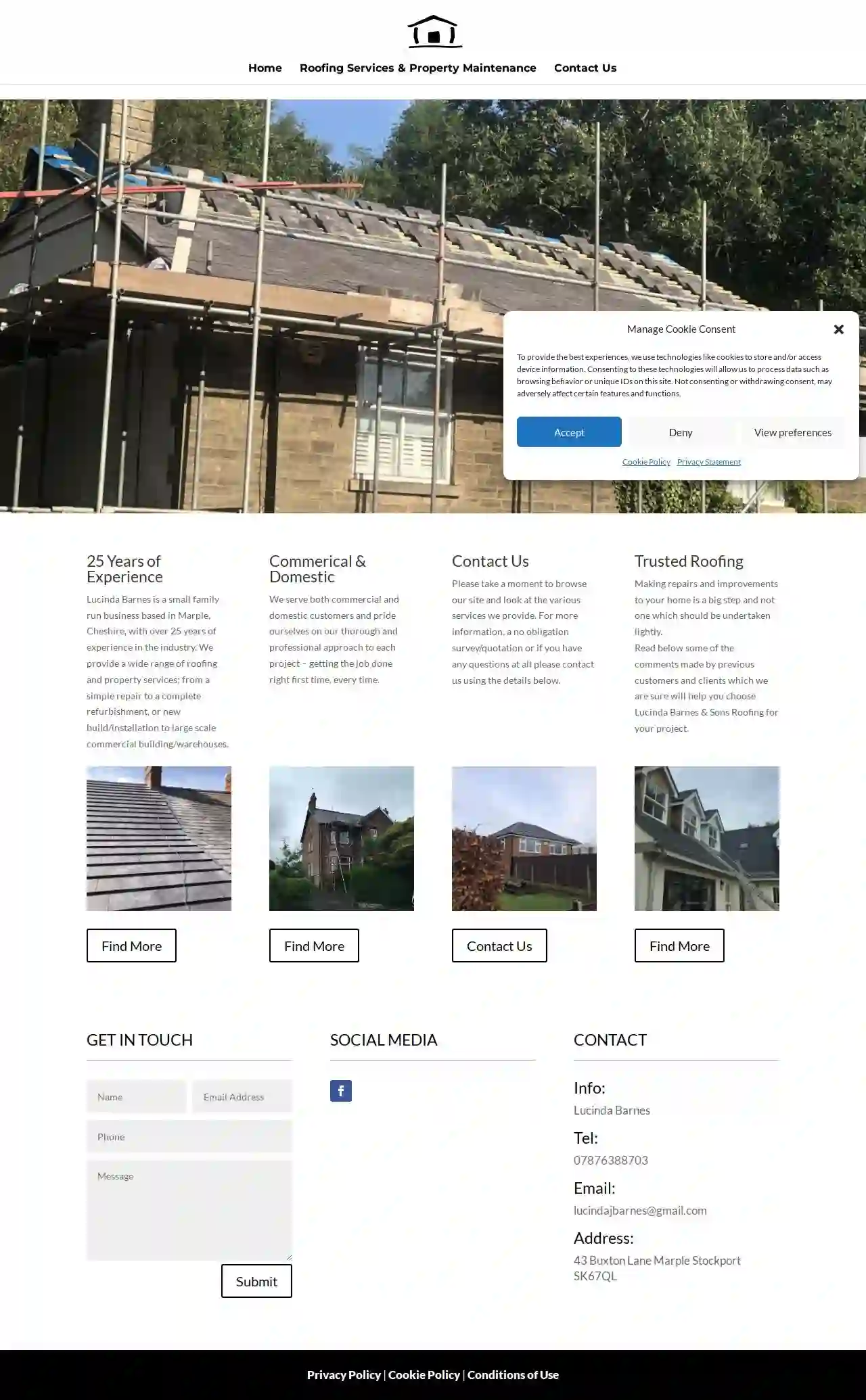
Lucinda Barnes & Sons Roofing
45 reviewsMarple, Stockport, 43 Buxton Lane, SK67QL, GBLucinda Barnes is a small family run business based in Marple, Cheshire, with over 25 years of experience in the industry. We provide a wide range of roofing and property services; from a simple repair to a complete refurbishment, or new build/installation to large scale commercial building/warehouses. We serve both commercial and domestic customers and pride ourselves on our thorough and professional approach to each project – getting the job done right first time, every time. Making repairs and improvements to your home is a big step and not one which should be undertaken lightly. Read below some of the comments made by previous customers and clients which we are sure will help you choose Lucinda Barnes & Sons Roofing for your project.
- Services
- Why Us?
- Gallery
Get Quote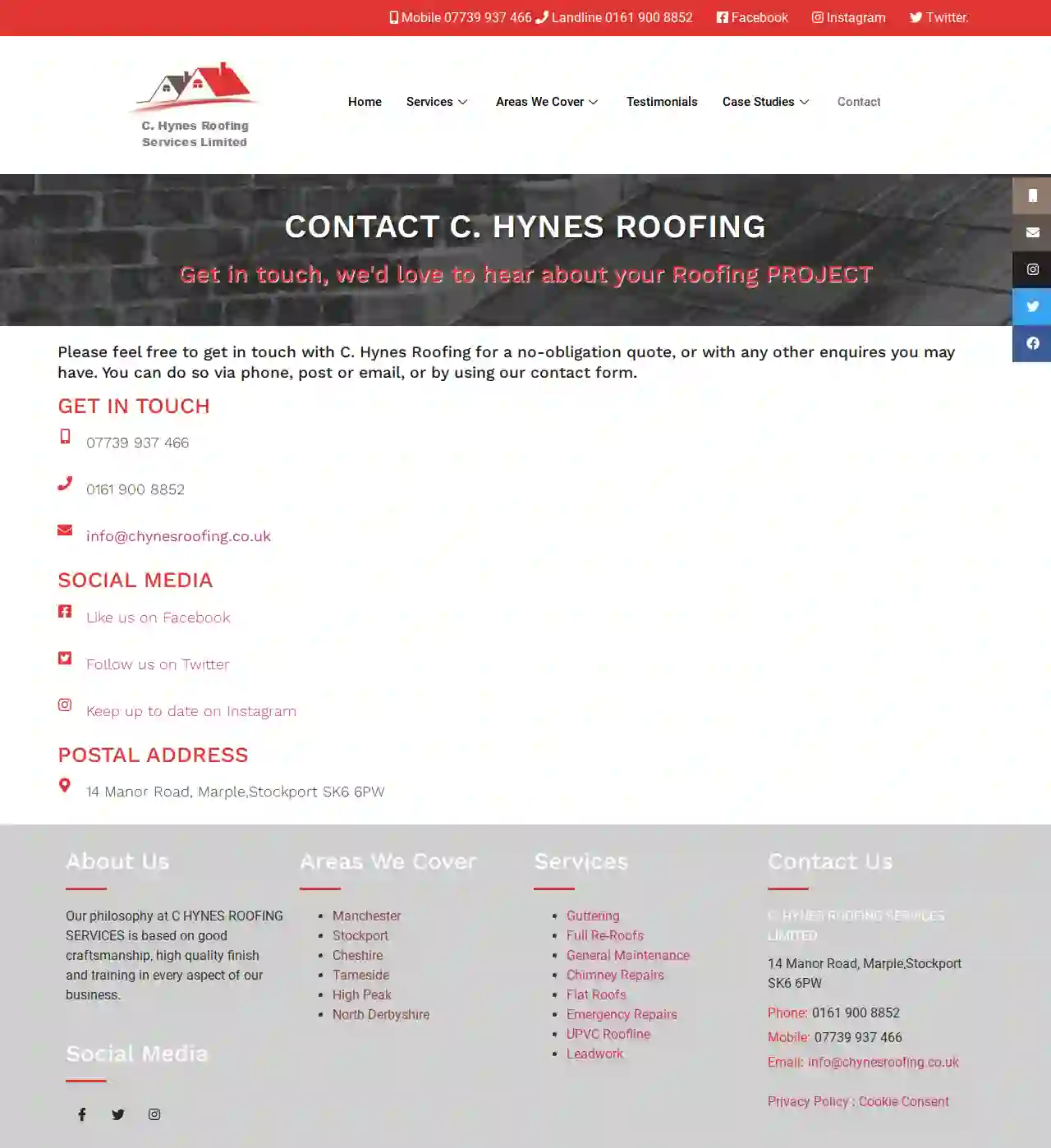
C Hynes Roofing
14 Manor Road, Marple, SK6 6PW, GBC. HYNES ROOFING SERVICES is a roofing company based on good craftsmanship, high quality finish and training in every aspect of our business. We use cookies and similar technologies on this website to help the site provide a better user experience. We value your privacy and want to be clear about the data we collect about you.
- Services
- Why Us?
- Accreditations
- Our Team
- Testimonials
- Gallery
Get Quote
K.H. Roofing
514 reviewsRegency Court, Deansgate, 62-66 Regency Court, Manchester, M3 2EN, GBK.H. ROOFING is a family-run roofing contractor based in Manchester, serving the North West region for the past 10 years. We pride ourselves on providing top-quality roofing services at affordable prices, with a focus on three key targets: efficiency, competitive pricing, and exceptional workmanship. Our commitment to customer satisfaction is evident in our reputation for consistently happy clients, with much of our business stemming from word-of-mouth referrals. We understand that a roof is a crucial part of your home, and we strive to ensure our customers have peace of mind. Our experienced team is available 24/7 to address any concerns and provide prompt assistance, whether it's a minor repair or a major project. We offer a wide range of services, including free consultations, repairs, maintenance, flat roof installation, slating and tiling, roof replacement, and fascia and guttering services. We use high-quality materials and guarantee our workmanship for 15 years, with some roofs lasting up to 50 years with proper maintenance.
- Services
- Why Us?
- Accreditations
- Our Team
- Testimonials
- Gallery
Get Quote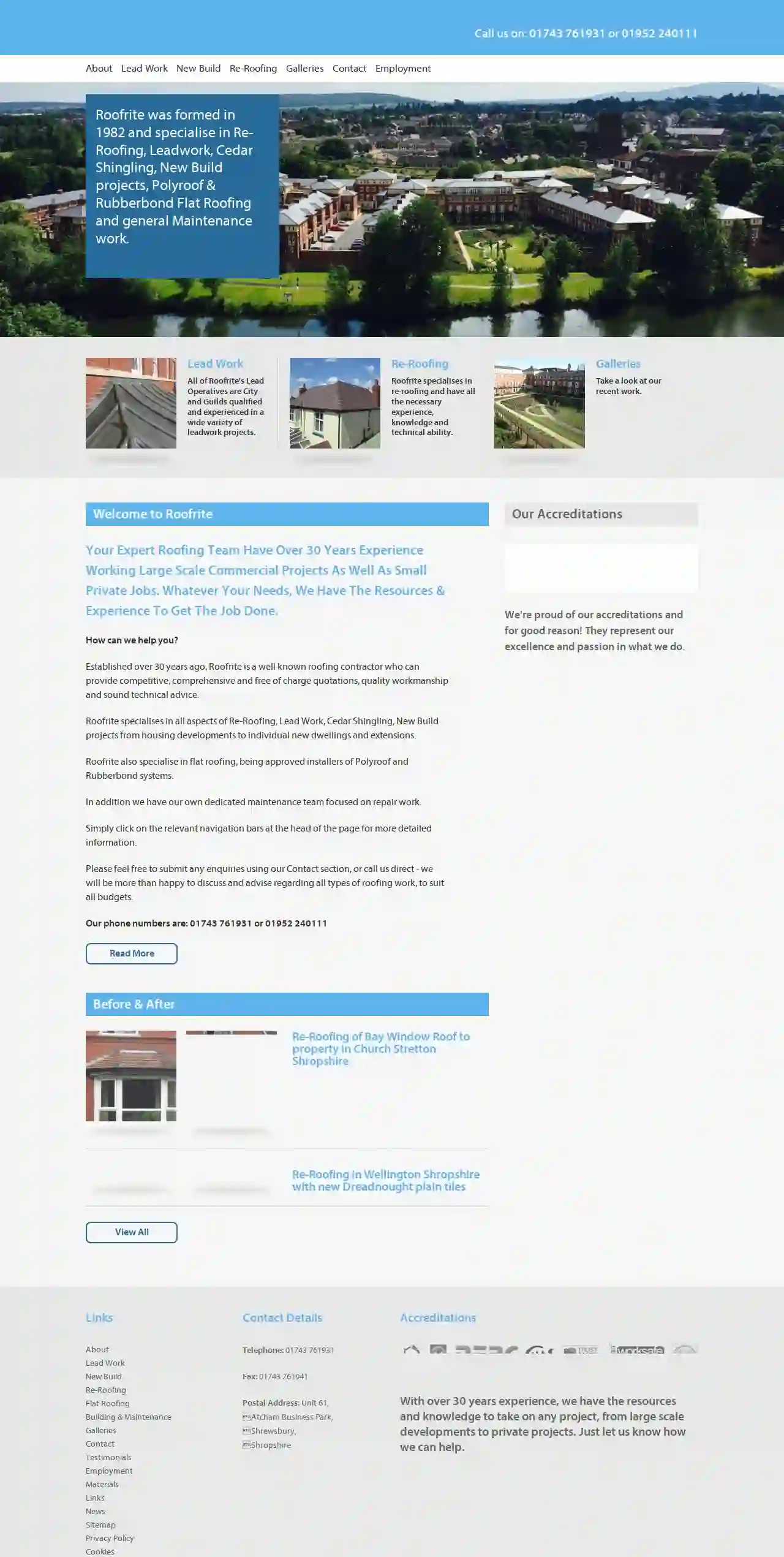
Roofrite
3.67 reviewsAtcham Business Park, Shrewsbury, Unit 61, SY4 5UP, GBRoofrite was formed in 1982 and specialise in Re-Roofing, Leadwork, Cedar Shingling, New Build projects, Polyroof & Rubberbond Flat Roofing and general Maintenance work. Established over 30 years ago, Roofrite is a well known roofing contractor who can provide competitive, comprehensive and free of charge quotations, quality workmanship and sound technical advice. Roofrite specialises in all aspects of Re-Roofing, Lead Work, Cedar Shingling, New Build projects from housing developments to individual new dwellings and extensions. Roofrite also specialise in flat roofing, being approved installers of Polyroof and Rubberbond systems. In addition we have our own dedicated maintenance team focused on repair work. Simply click on the relevant navigation bars at the head of the page for more detailed information. Please feel free to submit any enquiries using our Contact section, or call us direct - we will be more than happy to discuss and advise regarding all types of roofing work, to suit all budgets. Our phone numbers are: 01743 761931 or 01952 240111
- Services
- Why Us?
- Accreditations
- Gallery
Get Quote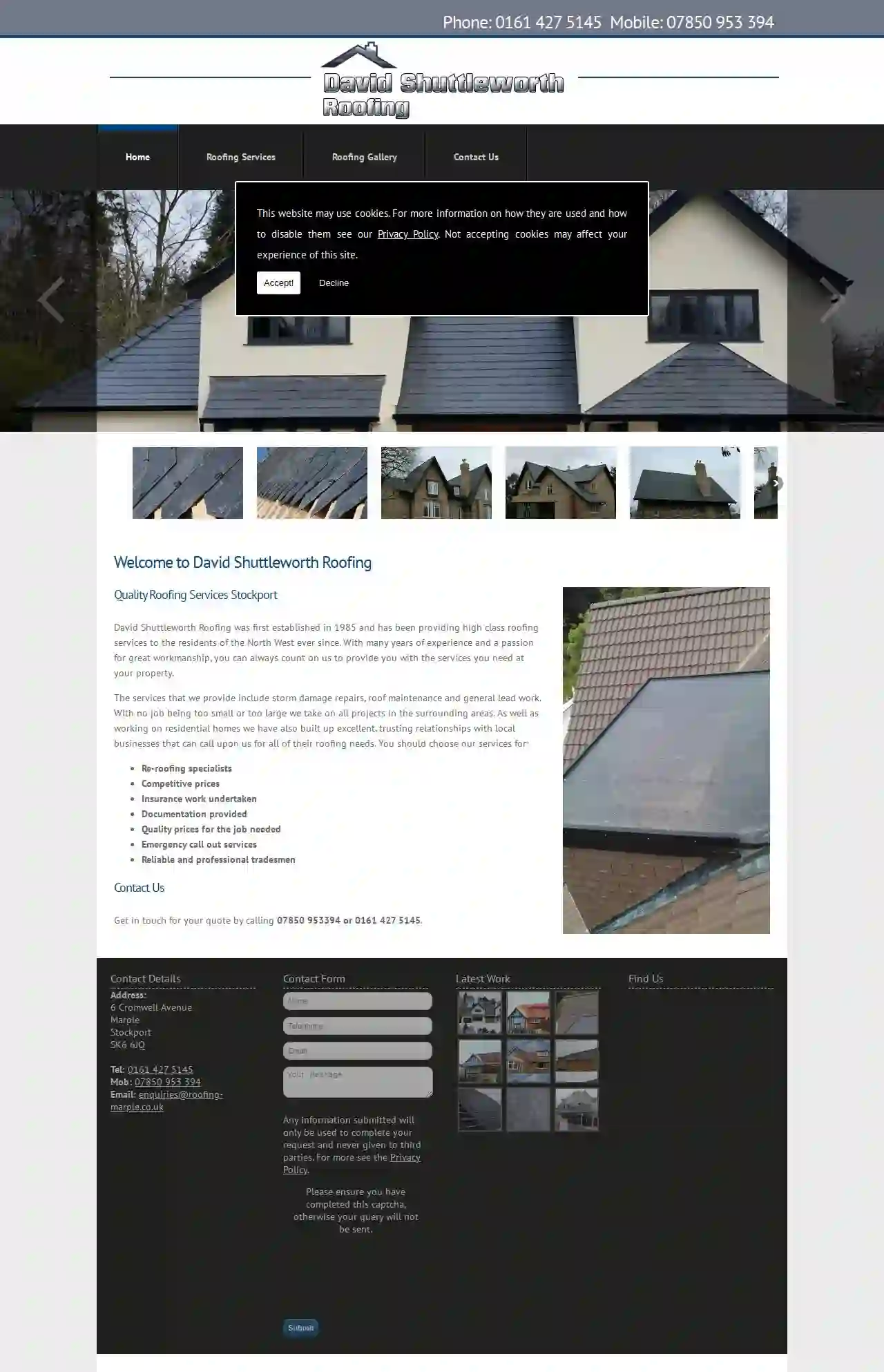
David Shuttleworth Roofing Contractor
6 Cromwell Avenue, Marple, SK6 6JQ, GBDavid Shuttleworth Roofing was first established in 1985 and has been providing high class roofing services to the residents of the North West ever since. With many years of experience and a passion for great workmanship, you can always count on us to provide you with the services you need at your property. We provide services including storm damage repairs, roof maintenance and general lead work. No job is too small or too large, we take on all projects in the surrounding areas. As well as working on residential homes we have also built up excellent, trusting relationships with local businesses that can call upon us for all of their roofing needs. You should choose our services for: Re-roofing specialists Competitive prices Insurance work undertaken Documentation provided Quality prices for the job needed Emergency call out services Reliable and professional tradesmen Contact Us Get in touch for your quote by calling 07850 953394 or 0161 427 5145
- Services
- Why Us?
- Gallery
Get Quote
Trafford Roofing Ltd
4.634 reviewsManchester, GBWelcome to Trafford Roofing Ltd. Professional roofers with over 40 years combined experience in a variety of quality roofing services. Covering the areas of Sale, Altrincham, Trafford, Stretford, Urmston, and surrounding areas. We take pride in being a reliable and trustworthy roofing company that delivers exceptional results. Our team of skilled roofers are experts in all aspects of roofing, from roof repairs and maintenance to new installations and re roofs. Taking pride in our professionalism and attention to detail. And ensuring that every job is completed to the highest standards. What’s more, as a family owned and operated company, we understand that your roof is the main protection for your property. Which is why we cater to the unique roofing needs of many different types of buildings. Whether you are a commercial business, or a home owner, we use only the best materials and roofing techniques to ensure the longevity and durability of your roof. At Trafford Roofing Ltd, we offer a wide range of roofing services, including: Roof repairs: From small leaks to major damage caused by storms or wear and tear. New roof installations: For a variety of different roof types. Our team can help you choose the best materials and design for your home or business. Re Roofs: If your roof is beyond repair, we can provide a full replacement to ensure the safety and integrity of your property. And with a team of highly skilled roofers who come fully trained and insured, you have peace of mind that your property is in safe hands from start to finish. We also offer competitive pricing and free, no-obligation quotes for all our roofing services. So, whether you need flat roofing, rubber roofing, or something else. Choose Trafford Roofing Ltd for all your roofing needs in Sale, Altrincham, Trafford, Stretford, Urmston, and surrounding areas. With our experience, professionalism, and dedication to customer satisfaction, you can trust us to provide the best roofing services for your property. Contact us today to schedule a consultation or request a quotation. Or visit our testimonials and gallery to learn more about our previous work.
- Services
- Why Us?
- Gallery
Get Quote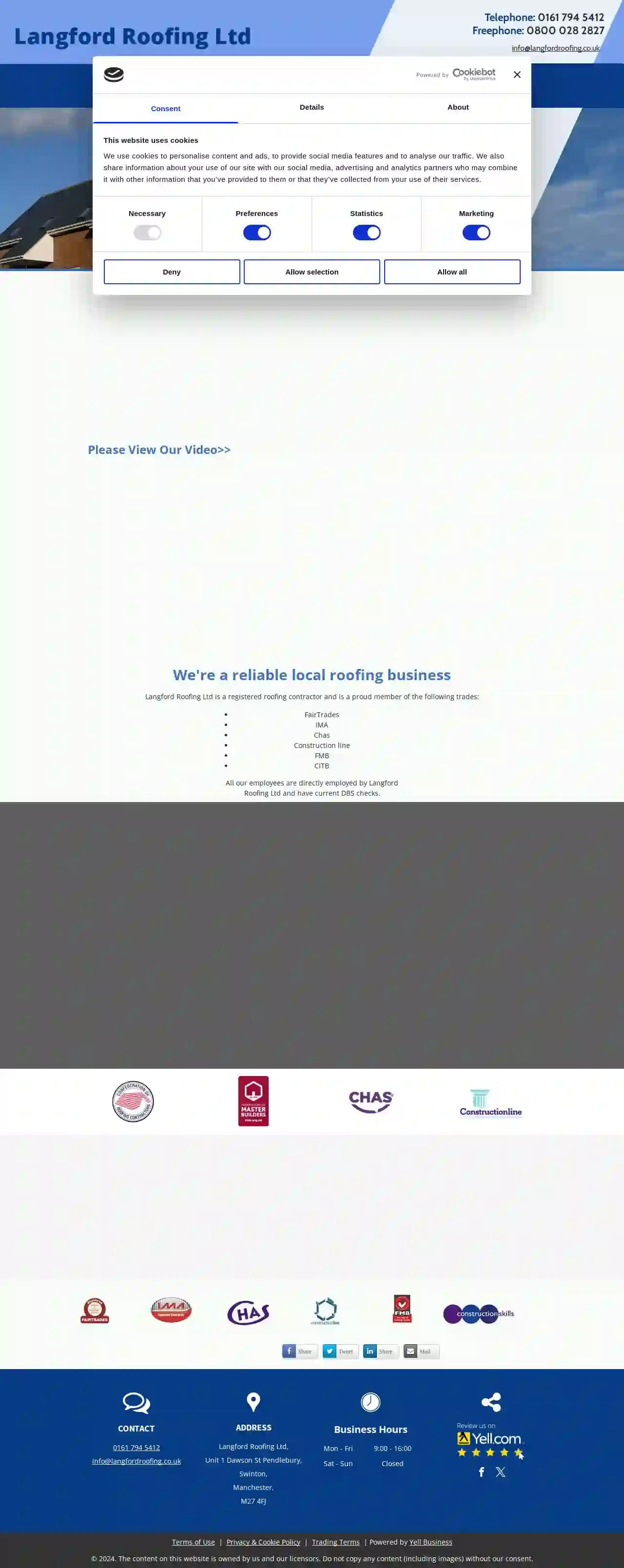
Langford Roofing Ltd
3.818 reviewsLangford Roofing Ltd, Unit 1 Dawson St Pendlebury, Swinton, M27 4FJ, GBLangford Roofing Ltd is a long established, local roofing company in Swinton, Greater Manchester. From complete re-roofs to gutter repairs, there’s no job too big or small for our team of roofing professionals. We’re a reliable roofing company in Manchester, over the years we have gained the trust of an impressive clientele. Many of our domestic, commercial and industrial clients are our repeat customers. Some of them are NHS Salford, Salford Education, Betfred Bookmakers, Joseph Holts Brewery. We are your one stop roofing specialists when you need roof repairs or installations. We provide roofing services throughout Manchester, Merseyside, Cheshire, Cumbria and Lancashire. Our customers are our assets. At Langford Roofing, we have more than 25 years of experience in providing expert roofing services in Swinton and across Manchester.
- Services
- Why Us?
- Accreditations
- Testimonials
- Gallery
Get Quote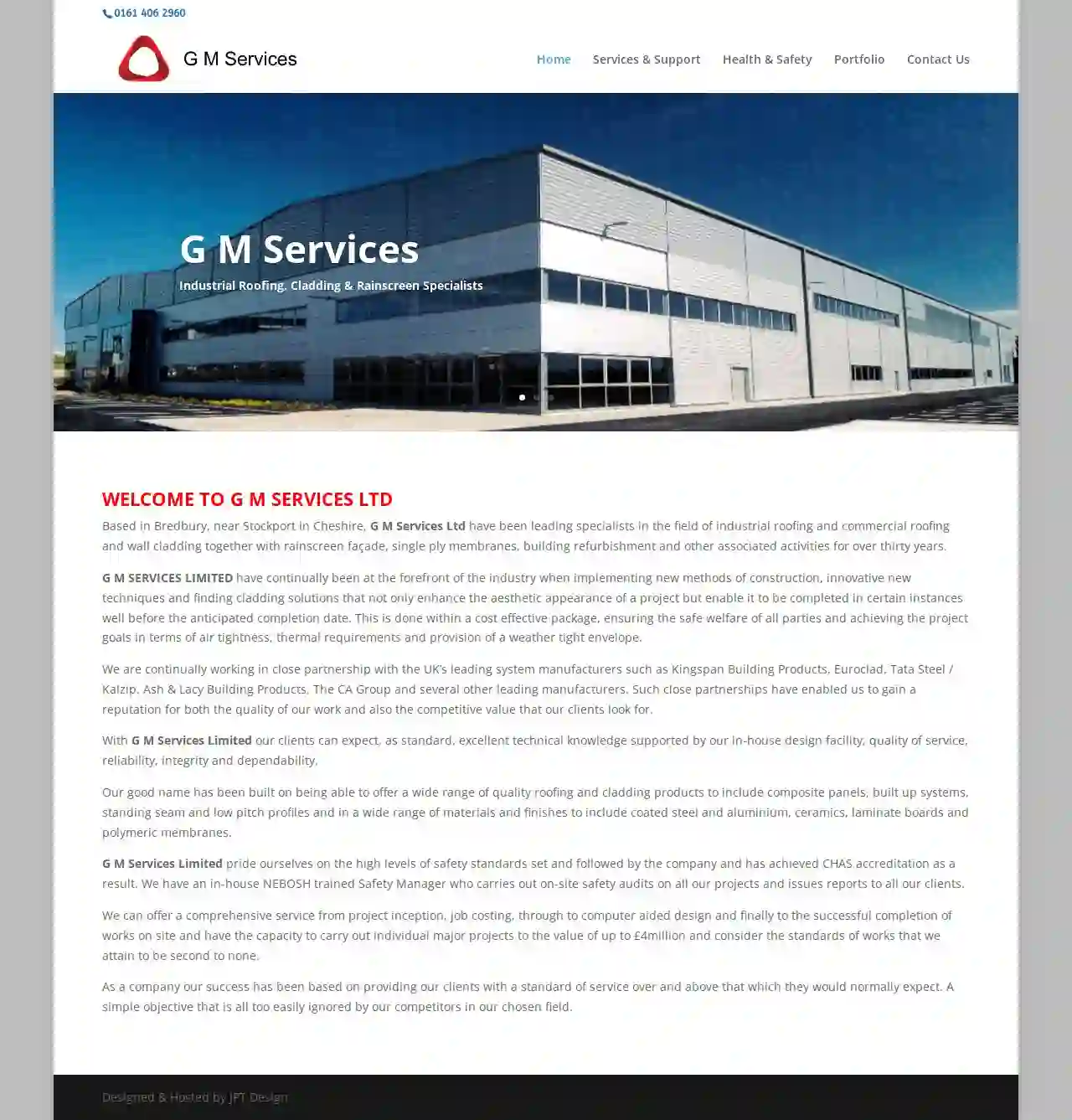
G M Services Ltd
4.68 reviewsWhitefield Road, Bredbury, SK6 2QR, GBWELCOME TO G M SERVICES LTD Based in Bredbury, near Stockport in Cheshire, G M Services Ltd have been leading specialists in the field of industrial roofing and commercial roofing and wall cladding together with rainscreen façade, single ply membranes, building refurbishment and other associated activities for over thirty years. G M SERVICES LIMITED have continually been at the forefront of the industry when implementing new methods of construction, innovative new techniques and finding cladding solutions that not only enhance the aesthetic appearance of a project but enable it to be completed in certain instances well before the anticipated completion date. This is done within a cost effective package, ensuring the safe welfare of all parties and achieving the project goals in terms of air tightness, thermal requirements and provision of a weather tight envelope. We are continually working in close partnership with the UK’s leading system manufacturers such as Kingspan Building Products, Euroclad, Tata Steel / Kalzip, Ash & Lacy Building Products, The CA Group and several other leading manufacturers. Such close partnerships have enabled us to gain a reputation for both the quality of our work and also the competitive value that our clients look for. With G M Services Limited our clients can expect, as standard, excellent technical knowledge supported by our in-house design facility, quality of service, reliability, integrity and dependability. Our good name has been built on being able to offer a wide range of quality roofing and cladding products to include composite panels, built up systems, standing seam and low pitch profiles and in a wide range of materials and finishes to include coated steel and aluminium, ceramics, laminate boards and polymeric membranes. G M Services Limited pride ourselves on the high levels of safety standards set and followed by the company and has achieved CHAS accreditation as a result. We have an in-house NEBOSH trained Safety Manager who carries out on-site safety audits on all our projects and issues reports to all our clients. We can offer a comprehensive service from project inception, job costing, through to computer aided design and finally to the successful completion of works on site and have the capacity to carry out individual major projects to the value of up to £4million and consider the standards of works that we attain to be second to none. As a company our success has been based on providing our clients with a standard of service over and above that which they would normally expect. A simple objective that is all too easily ignored by our competitors in our chosen
- Services
- Why Us?
- Accreditations
- Gallery
Get Quote
Allied Roofing & Construction
3.33 reviewsStockport, GBComplete Roofing Systems is a service-led roofing and cladding company with over 30 years of experience in delivering high-quality roofing projects for commercial, industrial, and public body clients. We pride ourselves on listening to our clients' needs and providing tailored solutions that meet their requirements and budget. Our services include installing new roofing and cladding systems, maintaining the long-life of existing coverings, and carrying out urgent repairs quickly and efficiently. We have expertise in various roofing systems, including metal sheeting and cladding, built-up felt systems, wall cladding, and more. Our team is dedicated to providing exceptional customer service and ensuring that our clients receive the best possible outcome for their roofing needs.
- Services
- Why Us?
- Accreditations
- Our Team
- Testimonials
- Gallery
Get Quote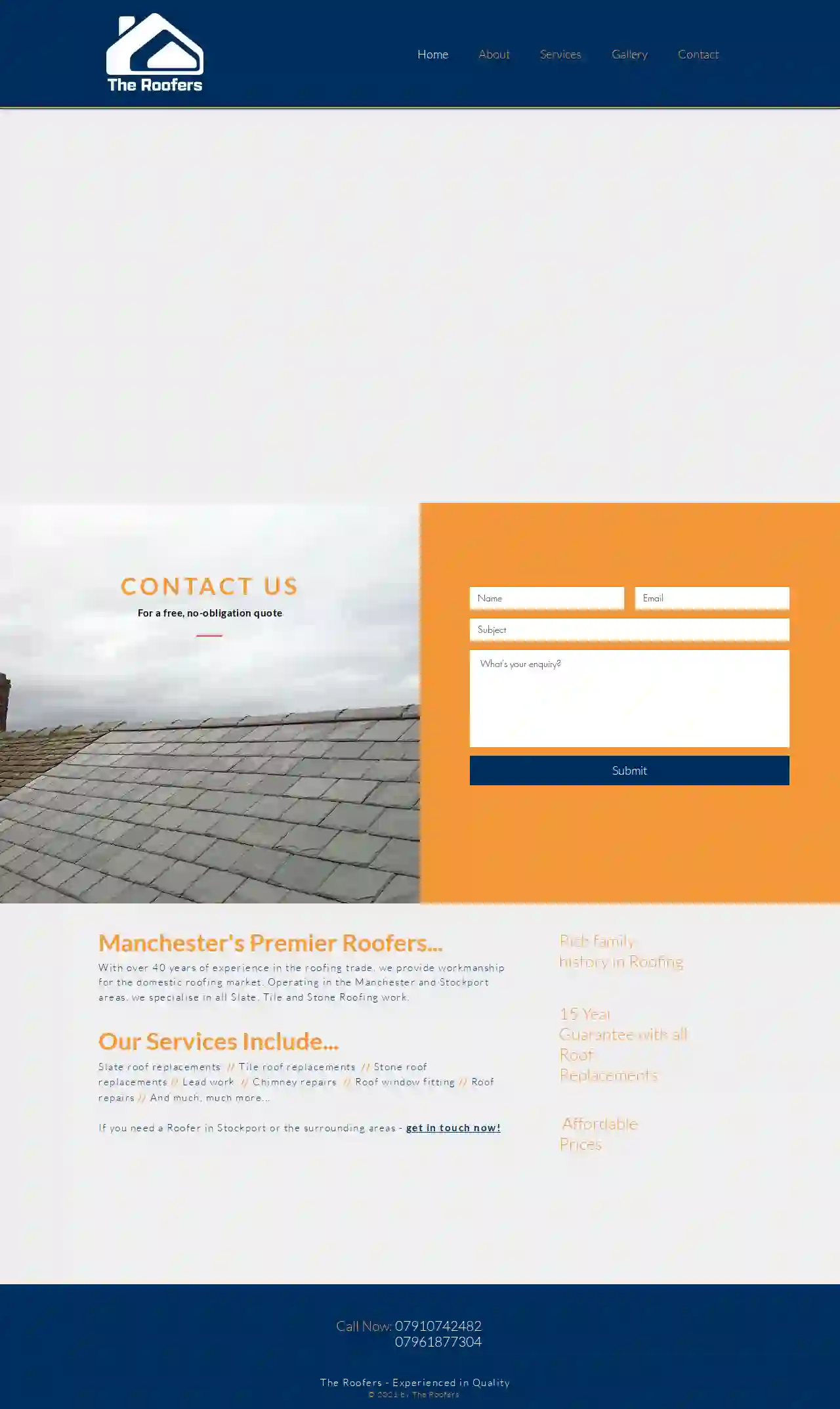
The Roofers
51 reviewsGBManchester's Premier Roofers... With over 40 years of experience in the roofing trade, we provide workmanship for the domestic roofing market. Operating in the Manchester and Stockport areas, we specialise in all Slate, Tile and Stone Roofing work. Our Services Include... Slate roof replacements, Tile roof replacements, Stone roof replacements, Lead work, Chimney repairs, Roof window fitting, Roof repairs, And much, much more... If you need a Roofer in Stockport or the surrounding areas - get in touch now! Rich family history in Roofing, 15 Year Guarantee with all Roof Replacements, Affordable Prices, Call Now: 07910742482. The Roofers - Experienced in Quality. Copyright 2021 by The Roofers.
- Services
- Why Us?
- Gallery
Get Quote
Over 12,314+ Roofers registered
Our roofing pros operate in Stalybridge and surrounding areas!
Roofyng.co.uk has curated and vetted the Best Roofing Contractors in and around Stalybridge. Find a top & trustworthy business today.
Frequently Asked Questions About Roofing Companies
- Choose Reflective Roofing Materials: Opt for light-colored shingles or metal roofing that reflects sunlight and reduces heat absorption.
- Install Proper Attic Insulation: Adequate insulation prevents heat loss in the winter and heat gain in the summer.
- Ensure Adequate Ventilation: Proper attic ventilation allows hot air to escape, reducing cooling costs and extending the lifespan of your roof.
- Consider a Radiant Barrier: In hot climates, a radiant barrier installed in the attic can reflect heat away from the roof, further reducing cooling needs.
- Listed Buildings: Buildings with historical or architectural significance.
- Conservation Areas: Areas with special architectural or historical character.
- Changes to Roof Design: If you're making significant alterations to the roof's design, such as adding a dormer window or changing the pitch.
What should I do with my old roof after replacement?
How can I make my new roof more energy-efficient?
What is fascia, and why is it important?
Do I need planning permission to replace my roof in the UK?
What should I do with my old roof after replacement?
How can I make my new roof more energy-efficient?
- Choose Reflective Roofing Materials: Opt for light-colored shingles or metal roofing that reflects sunlight and reduces heat absorption.
- Install Proper Attic Insulation: Adequate insulation prevents heat loss in the winter and heat gain in the summer.
- Ensure Adequate Ventilation: Proper attic ventilation allows hot air to escape, reducing cooling costs and extending the lifespan of your roof.
- Consider a Radiant Barrier: In hot climates, a radiant barrier installed in the attic can reflect heat away from the roof, further reducing cooling needs.
What is fascia, and why is it important?
Do I need planning permission to replace my roof in the UK?
- Listed Buildings: Buildings with historical or architectural significance.
- Conservation Areas: Areas with special architectural or historical character.
- Changes to Roof Design: If you're making significant alterations to the roof's design, such as adding a dormer window or changing the pitch.